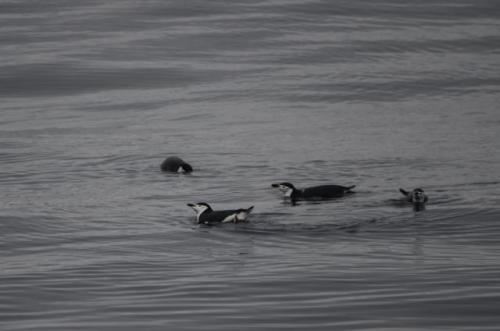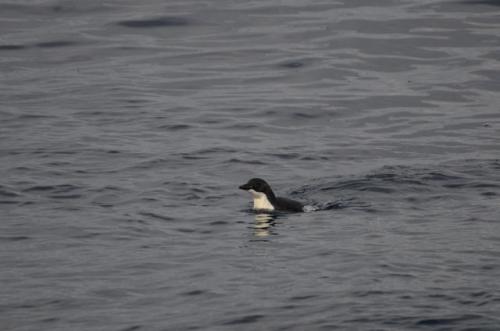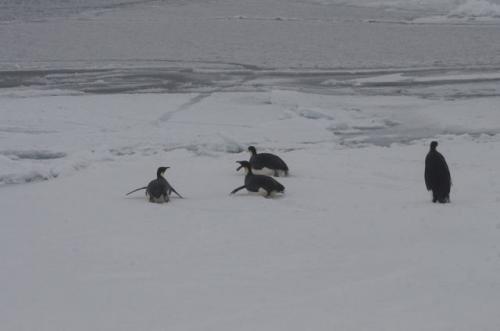Yesterday we received the visit of six Chinstrap penguins while we were at a station. The remained next to the boat for a long time, apparently feeding. These are the first penguins I have seen that I can say with certainty are Chinstrap. You will see in one of the pictures below why they are named like that.

These penguins look more like ducks on the surface of the water than what we had seen with the Adélies, because their bodies are stick out more above the water. In fact, when we were talking about the visit at dinner time, Kevin said he had seen some birds floating close to the bow, but thought they looked like ducks or other large flying birds.

In the picture above you might see the black pigmentation in their chin that looks like a strap. Chinstrap penguins are about 68 - 76 cm tall and weight between 3.2 - 5.3 kg according to the guide I am using (Shirihai, H., 2008. The Complete guide to Antarctic Wildlife). Chinstrap penguins have a distribution that overlaps between true Antarctic penguins, like Adélies, Kings, Gentoo and Emperors, and those in the subantarctic islands (12 more species). They are found mostly around latitude 60 S (we are still at 67 S), and near Scotia Sea.
Below is a picture of an Adélie we saw a few weeks ago. You can see its body is more underwater than the Chinstraps, as well as the different head coloration among both species. Adélie penguins are similar in size to the Chinstrap penguins (70 - 71 cm height and 3.8 - 8.2 kg weight) and can be hard to distinguish from the Chinstrap as juveniles since young Adélies have whiter necks than adults.

And since we are talking about penguins, here is a picture of some Emperor penguins we saw this past week. Emperors slide on their belly an the snow, which is called tobogganing, a lot more than Adélies do, according to what I have observed. Tobogganing requires far less energy for these large penguins than walking. Emperor penguins endure the coldest conditions of any bird and are confined to live on pack ice, fast-ice (melts in the summer) and adjacent seas.

Emperors are the largest penguins of them all, with a height of 1.0 to 1.3 meters and weight of 20 to 41 kg. They are found usually south of the 66 S latitude, although some have made it New Zealand and South American coasts. We will be very lucky to see another one. The have been portrayed a lot in movies in recent years, with 'March of the penguins' and 'Happy feet' among the most famous, because of their peculiar breeding cycle. Females lay a single egg per season between May and June far from the coast (160 km away from where the cost will be when they go back to the water); males incubate the egg alone for 62 - 67 days in which they do not eat anything, while females stay in the water eating. Males form large groups to huddle against the cold and each hold their egg between their feet to prevent it from touching the ground so it does not freeze. Females return to the colony in time for the chick's emergence to feed him. The male is the first to feed the chick with secretions of fat and protein, and then travel to the sea to feed. And here they go, happily tobogganing away.

We have had the most unantarctic seas in the past five days, and I hope they stay like that. Very calm seas with no wind. I hope to have the same luck as we cross the Drake PassageStrait, connecting the Atlantic and Pacific oceans between Tierra del Fuego and the South Shetland Islands. Located about 100 mi (160 km) north of the Antarctic Peninsula, it is 600 mi (1,000 km) wide.. The skies are still overcast, but that is not a surprise anymore. We have two more days of hydrographic stations. I can not believe the cruise is coming to an end. I have had so much fun learning all this things that I am sharing with you.
Más sobre Pingüinos
Ayer recibimos la visita de unos pingüinos chinstrap ( significa cinta en la barbilla, pero no se el nombre en español) que se acercaron al barco mientras estábamos en una estación, aparentemente alimentándose. Estos son los primeros pingüinos que vemos que puedo decir con confianza que se tratan de Chinstrap. Ya verás en una de las fotos de dónde sale el nombre.

Estos pingüinos flotan más sobre el agua que los pingüinos Adélie, por lo que parecen patos. De hecho, cuando comentábamos el avistamiento a la hora de la cena, Kevin dijo que los había visto de pasada y pensó que eran algún tipo de pájaro volador.

Quizá puedes ver en la foto de arriba la pigmentación que da la apariencia de una cinta en la barbilla. Los pingüinos Chinstrap miden entre 68 y 76 cm de alto y pesan entre 3.2 7 5.3 kilos de acuerdo a la guía que estoy usando (Shirihai, H., 2008. The Complete guide to Antarctic Wildlife). Estos pingüinos tienen una distribución que se traslapa con los que la guía llama pingüinos Antárcticos, como lo sAdélie, King, Gentoo y Emperadores, y los que están en las islas subantárcticas (12 especies más). Se encuentran cerca de la latitud 60 S (nosotros estamos en la 67 S actualmente) y cerca del Mar de Scotia.
La foto de abajo muestra un pingüino Adélie que se acercó al barco hace unas semanas. Puedes ver que su cuerpo queda más hundido que el de los Chinstrap, así como la diferente coloración en la cabeza. Los pingüinos Adélie son de tamaño similar a los Chinstrap (70 - 71 cm de altura y 3.8 - 8.2 kg de peso). Es difícil distinguir los juveniles de ambas especies ya que los Adélie tienen más pigmentación blanca en el cuello y la cara que los adultos.

Y ya que hablamos de pingüinos, es buen momento para poner fotos de un grupo de pingüinos Emperador que vimos esta semana. De acuerdo a mis observaciones, los Emperadores se deslizan sobre su panza, lo que se conoce com o tobogán, más que los Adélie. El toboganeo requiere menos energía que el caminar en estos grandes pájaros. Los pingüinos Emperadores son los pájaros que toleran las más bajas temperaturas, y viven en las áreas con hielo y aguas aledañas.

Los Emperadores son los pingüinos más grandes y robustos, con una altura de 1.0 a 1.3 metros y un peso entre 20 y 41 kg. Se les encuentra al sur de la latitud 66 S, aunque algunos han llegado hasta las costas de América del Sur y de Nueva Zelanda. Necesitaremos mucha suerte para ver otro de los pingüinos Emperador. Estos pingüinos han recibido mucha atención mediática, particularmente con las películas 'La marcha de los pingüinos' y 'Happy feet', en años recientes por su peculiar forma de reproducción. La hembra pone un huevo único por temporada entre mayo y junio lejos de la costa (160 km de donde estará la orilla del mar cuando sea tiempo de regresar a ella); el varón incuba el huevo por 62 a 67 días durante los cuáles no come nada, mientras la hembra está en el mar alimentándose en exceso. Los varones se juntan en grupos grandes para protegerse del frío y mantienen el huevo entre sus pies evitando que éste toque el piso para que no se congele. Las hembras regresan a la colonia a tiempo para la salida del huevo para poder alimentarlo. El varón es el que le da el primer bocado, una secreción de proteínas y grasas, y después se va al agua a comer. Y aquí van, toboganeando felices de la vida.

Hemos tenido los mares menos Antárticos que nos pudiéramos imaginar durante los últimos cinco días, y espero que sigan así. El mar en calma y con poco viento. Espero tener la misma suerte al cruzar el pasaje de Drake. EL cielo sigue nublado, pero eso ya no me sorprende. Tenemos tan solo dos días más de muestreos hidrográficos. Me cuesta creer que el crucero está llegando a su fin. Me he divertido muchísimo aprendiendo todo lo que comparto contigo.


Comments